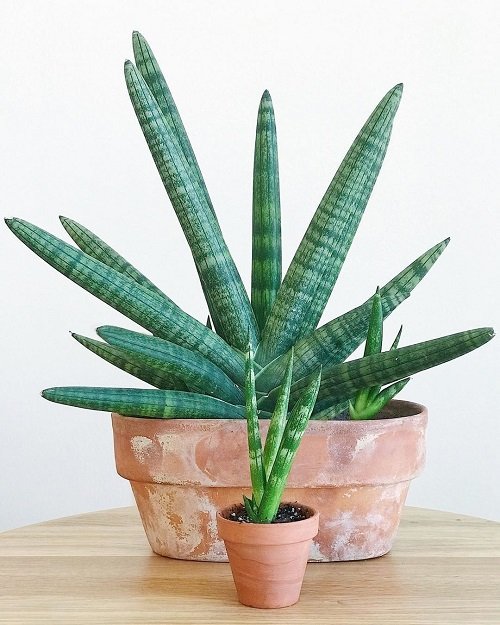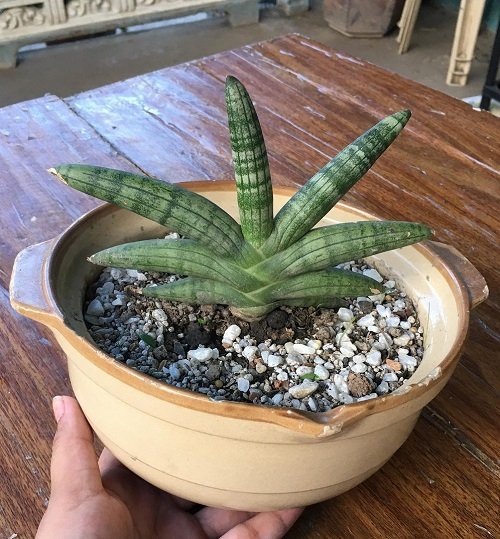
Starfish Sansevieria Growing Guide | Sansevieria cylindrica Care
Master the art of cultivating Starfish Sansevieria and incorporate this compact yet stunning succulent into your home decor!

What sets Starfish Sansevieria apart from other houseplants is the unique form of its cylindrical leaves, which spread in a hand-like shape. This charming and unconventional plant is a definite indoor essential!
Starfish Sansevieria Information
Starfish Sansevieria (Sansevieria cylindrica) is a distinctive succulent known for its cylindrical leaves that resemble starfish arms. Native to Africa, it features clustered rosettes with grayish-green leaves and light bands. Easy to care for, it thrives in various light conditions and requires infrequent watering. Its unique appearance and air-purifying qualities make it a popular choice for indoor decor.
Botanical Name: Sansevieria cylindrica ‘Boncel’
Common Name: Spear Orchid, Spear Orchid, or Starfish Snake Plant
Have a look at the Snake plant water propagation here
What’s the Difference: Starfish Sansevieria vs Cylindrical Snake Plant?
Starfish Sansevieria and Cylindrical Snake Plant (Sansevieria cylindrica) are often confused due to their similar appearance, but they are distinct varieties within the Sansevieria family. Here’s how they differ:
- Starfish Sansevieria (Sansevieria cylindrica):
Leaves: Starfish Sansevieria has cylindrical leaves that spread in a star-like pattern, resembling the limbs of a starfish.
Growth: It forms rosettes of cylindrical leaves that can vary in height and arrangement.
Appearance: The leaves are typically grayish-green with bands of lighter color.
Common Name: It’s commonly referred to as “Starfish Sansevieria.”
- Cylindrical Snake Plant (Dracaena angolensis):
Leaves: Cylindrical Snake Plant also has cylindrical leaves, but they are often more tightly clustered and can grow taller.
Growth: The leaves can grow more vertically and closely packed, sometimes with a slight curve.
Appearance: It exhibits variations in color and pattern on the leaves, including dark green and lighter green hues.
Common Names: It’s known as “Cylindrical Snake Plant” or “Cylindrical Sansevieria.”
In summary, while both Starfish Sansevieria and Cylindrical Snake Plant share similar cylindrical leaf shapes, their growth patterns, leaf arrangements, and minor visual differences set them apart. It’s important to identify the specific variety you have to care for it appropriately.
Propagating Starfish Sansevieria: How To?

Propagating Starfish Sansevieria:
- Leaf Cuttings: Take healthy leaves and cut them into sections, each about 2-3 inches long. Allow the cut ends to dry and callous for a day or two.
- Planting: Plant the dried leaf sections in well-draining succulent soil, burying about half of each section. Water the soil lightly.
- Rooting: Place the pot in a warm, bright location with indirect sunlight. Keep the soil slightly moist but not soggy. Roots will begin to develop in a few weeks.
- New Growth: As the new shoots emerge from the base of the leaf sections, they’ll grow into new plants. This can take several months.
- Separation: Once the new plants have grown a few inches tall and have their own roots, carefully separate them from the original leaf section.
- Transplanting: Repot the new plants into individual pots with succulent soil. Follow regular care guidelines for mature Starfish Sansevieria.
Remember, propagation is a gradual process, and patience is key. Not all leaf sections may successfully grow into new plants, so it’s good to take a few cuttings to increase your chances of success.
Requirements for Growing and Caring for Starfish Sansevieria

Light:
- Thrives in bright, indirect light.
- Tolerates low light conditions, but avoid direct sunlight to prevent leaf damage.
Temperature:
- Prefers temperatures between 65°F to 85°F (18°C to 29°C).
- Protect from temperatures below 50°F (10°C).
Soil:
- Use well-draining succulent or cactus potting mix.
- Prevents waterlogging and promotes healthy root growth.
Watering:
- Wait until the upper inch or two of soil is dry before watering again. Water sparingly, typically every 2-4 weeks during the growing season.
- Reduce watering frequency in winter to prevent overhydration.
Humidity:
- Adaptable to normal household humidity levels.
Pot:
- Select a pot with drainage holes to avoid water accumulation at the root.
Fertilization:
- Feed with a balanced, diluted fertilizer every 4-6 weeks in the growing season (spring and summer).
- Avoid over-fertilization, as succulents are low feeders.
Propagation:
- Easily propagated through leaf cuttings.
- Allow cuttings to callous for a day or two before planting.
Pruning:
- Trim dead or yellowing leaves at the base using clean scissors or shears.
- Redirects energy to new growth and maintains plant appearance.
Pests:
- Regularly inspect for mealybugs and spider mites.
- Treat infestations with insecticidal soap if necessary.
Air Circulation:
- Provide adequate air circulation to prevent stagnant air around the plant.
- Helps maintain overall plant health.
By following these specific requirements, you can ensure the successful growth and well-being of your Starfish Sansevieria.
Toxicity

Starfish Sansevieria, like other plants in the Sansevieria family, is considered toxic to pets and humans if ingested. The plant contains saponins, which can cause gastrointestinal discomfort, nausea, vomiting, and diarrhea if consumed. It’s important to keep Starfish Sansevieria out of reach from pets and small children to prevent accidental ingestion. If ingestion is suspected, seek medical attention for pets or humans immediately.
Frequently Asked Question?
How Large Does Starfish Sansevieria Grow?
Starfish Sansevieria generally reaches a compact size, growing to around 6-8 inches in height and spanning 12-18 inches in width. Its individual leaves extend to about 3 inches long. With attentive care and optimal surroundings, this charming succulent has the potential to achieve a slightly larger size.
Conclusion
Starfish Sansevieria (Sansevieria cylindrica) stands as a captivating addition to indoor spaces with its distinctive cylindrical leaf clusters resembling the arms of a starfish. Its unique appearance, coupled with its adaptability to various light conditions and low-maintenance nature, makes it an ideal choice for both seasoned plant enthusiasts and beginners alike. By providing the right care – including proper lighting, well-draining soil, controlled watering, and occasional pruning – you can enjoy the beauty and air-purifying benefits of Starfish Sansevieria in your home or office environment.




Average Rating